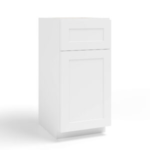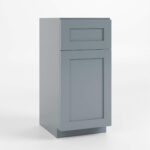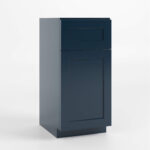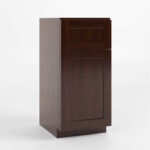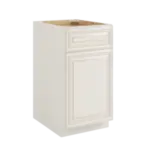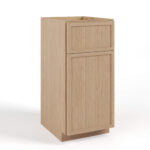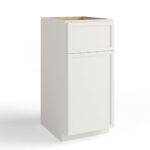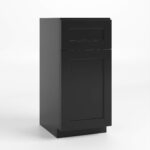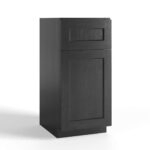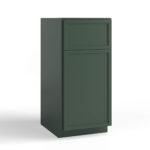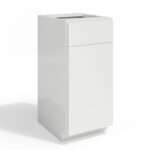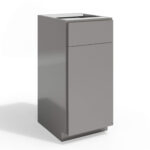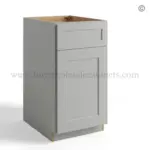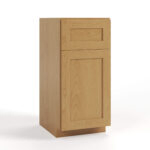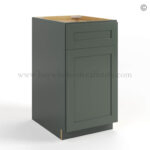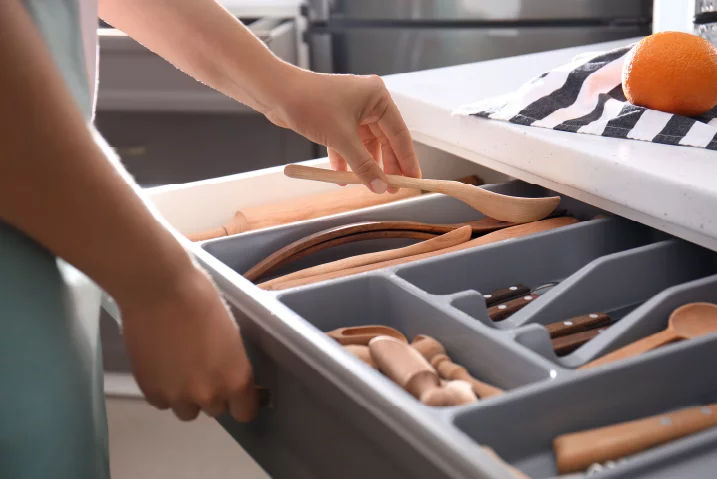Table of Contents
Do you know that feeling when you open a cabinet door, and it feels like everything is about to fall out? We get it; we have all been there. Tiny kitchens, limited cabinet space, crowded countertops, and somehow, too many small appliances taking up every inch. It is very stressful. Sometimes, it makes you feel like you just can’t cook properly because there is no space.
If your kitchen always feels too small, no matter how much you clean or organize, you are not alone. Most of us just have more stuff than cabinet space to keep it all in. This guide walks through simple, practical ways to make the most of what you already have; no fancy renovations or expensive organizers are needed. You will learn how to rethink the space you already have. The tips cover everything from using tension rods and lazy Susans to stacking shelves and hanging mugs.
Evaluate Your Kitchen Layout Before Organizing
Before you run to buy all the organizers you see online, it is worth slowing down and looking at your kitchen properly. If you skip this part, you might end up with stuff that does not fit or just adds to the clutter.
Take Inventory of Your Cabinets
Start by opening every cabinet door. Pull out the drawers, too. Take a good look at what you actually have. Writing it down can help because otherwise you forget, especially the pantry items that are hiding in the back.
- Think about what you use every day and what just sits there. That Dutch oven you love but only use on weekends, or that dish rack that never seems to have a dish on it.
- Notice where cleaning supplies are hiding. Sometimes, they take up a lot of cabinet space that could be used for food or small appliances.
- Look at oddly shaped items that never seem to fit anywhere. Those need creative storage, or they waste a lot of space.
Measure Your Space
Tiny kitchens do not leave room for guesswork, and measuring first can save so much frustration later.
- Measure the height, width, and depth of each cabinet. Don’t forget corners.
- Look at any empty wall space or the space above kitchen cabinets. You can use vertical space in ways you might not have thought about.
- Check drawers too. Even small drawers can be used better with drawer dividers or little organizers.
Measuring is tedious, but knowing the exact size of your cabinet space, wall space, and extra counter space will make it much easier to pick solutions that actually work.
Identify Problem Areas
At this point, you know what is in your cabinets and how big everything is. Now look for the spots that are actually a problem.
- Are your countertops crowded with small appliances that you do not use all the time?
- Are some shelves packed so tightly that you cannot even see what is in the back?
- Do certain drawers feel like black holes where things go in and never come out?
Once you figure out the problem area, it is easier to know what storage hacks will help. Lazy Susans, hooks, pull-out shelves, shelf risers, open shelving, or multi-functional furniture can all help, but only if you put them in the right place.
15 Kitchen Hacks to Organize a Kitchen with Limited Cabinet Space
Okay, so now that we’ve done all the prep work and stared at our tiny kitchens long enough, let’s get into the hacks. Honestly, some of these are things you probably thought of, but a few are the kind of small tweaks that actually change the way you use your kitchen.
1. Install Cabinet Door Organizers
You never really think about the inside of my cabinet doors until you get tired of digging for spice jars. There’s so much unused space there, and it’s honestly frustrating to leave it empty. You can add a few tracks and hooks, mostly for spices and lids, and suddenly everything feels more accessible. You can even put cleaning supplies there if you want, things you don’t use every day.
What’s nice is that you can arrange it around. If a spice jar changes or you get a new kitchen gadget, you just move the hooks. For a small kitchen, it’s a lifesaver because every square inch counts. One can use it for small pantry items, too. It’s not glamorous, but it works. And the best part is, you don’t have to pull everything out of the cabinet to get what you need. It makes cooking less stressful, and the kitchen just feels easier to use.
| Purpose | What to Store | Best Type of Organizer | Why It Helps |
| Cooking Essentials | Spice jars, measuring spoons, and small oil bottles | Narrow racks or tiered shelves | Keeps your most-used items right where you can grab them while cooking |
| Cleaning Supplies | Brushes, gloves, spray bottles | Hanging hooks or mini baskets | Frees up under-sink space and avoids clutter on counters |
| Lids & Covers | Pot lids, pan covers, cutting boards | Adjustable lid holders or vertical racks | Stops the loud lid-jumble and saves space inside cabinets |
| Pantry Items | Tea boxes, small condiments, foil rolls | Small shelves or clips | Keeps small things visible instead of buried in the back |
| Miscellaneous | Scissors, bag clips, measuring cups | Adhesive hooks or clip-on holders | Helps you find everyday tools fast without rummaging |
2. Use Stackable Shelf Organizers
Stackable shelves are one of those things. Our shelves always had tall and short things all mixed together. We stacked plates, bowls, and even some containers for pantry items. The vertical space that used to sit in sympathy suddenly became useful. It didn’t need more cabinets or counter space, but better organization.
It also stops things from tipping over. Before, you’d reach for a plate and knock over a stack of bowls. Now, everything sits neatly. You can even put a small appliance or two on the top shelf without worrying about it falling. If your kitchen feels cramped, stacking shelves is such an easy way to create more usable space. It’s simple, cheap, and makes the cabinet feel more organized instantly.
3. Opt for Adjustable Shelving
Fixed shelves can be annoying. Sometimes they’re too close together or too far apart. You can get it swapped for a few adjustable ones, and you will find that suddenly you can fit taller things like my Dutch oven or add another shelf for smaller items. It’s just so much easier to use vertical space when you can move the shelves around.
4. Use Hooks for Mug and Utensil Storage
Hooks are ridiculously simple but effective. You can hang mugs under the cabinet and utensils nearby. It frees up cabinet shelves and also gives a little extra counter space, which is huge in a tiny kitchen. You can use a space, too, if you have it. Even a few hooks for pots or a small basket work.
It’s funny how much difference it makes. Things are easier to reach, and you don’t have to dig through basketfuls of boulders for a spatula or a whisk. It also feels less crowded while cooking. One wouldn’t think hooks would change much, but they really do. For small kitchens, it’s one of the easiest ways to use vertical space and reclaim a few square inches.
5. Invest in Under-Shelf Baskets
Under-shelf baskets are basically invisible storage. They clip onto your existing shelves and give you an extra layer of saved space. You can use them for small pantry items and dish towels. They make the space above my things useful instead of wasted.
You will find yourself noticing that it keeps everything more organized. Before, jars and containers were stacked awkwardly. Now, you can see what at a glance. It’s simple, inexpensive, and makes a big difference for a tiny kitchen. These baskets give back a surprising amount of cabinet space without adding clutter or taking over the counters.
6. Use Lazy Susans in Corner Cabinets
Corner cabinets are the trickiest spots in a kitchen. They’re deep and dark, and things get lost in there for months. One can’t tell you how many times they have found an old bag of flour hiding in the back because they just couldn’t reach it.
A lazy Susan completely changes that. You just spin it, and suddenly everything comes into view, whether it’s spices, oils, or even small appliances, if your corner cabinet is large enough. It saves so much cabinet space because nothing gets shoved into the forgotten “black hole” zone.
Plus, it’s surprisingly fun to use. It feels like having a mini rotating shelf riser that makes the most of the square inches you’d normally waste. If your kitchen has limited space, this one small trick will feel like it doubled your storage.
7. Utilize Drawer Dividers
Drawers without dividers become a jumble so quickly. You toss in forks, knives, and measuring spoons, and before you know it, you’re digging around for that one tiny whisk. Drawer dividers bring order to all of it. It’s such a simple fix, but it maximizes every square inch of drawer space.
Suddenly, you’ve got a proper spot for utensils, dishcloths, and even small pantry items like seasoning packets. The best part is that you don’t need fancy or expensive organizers. Even simple wooden or plastic dividers do the job. If you live with limited cabinet space, using your drawers well is essential.
8. Install Pull-Out Shelves or Bins
Have you ever crouched down to reach something in the very back of a lower cabinet? It’s uncomfortable and usually ends with you pulling out half the shelf just to find one pan. Pull-out shelves or bins completely fix this. You slide them out, grab what you need, and slide them back in. It’s a great way to use deep cabinet space without feeling like you’re losing access.
Pull-out bins also work well for cleaning supplies under the sink or even pantry items like jars and cans. This setup really saves space because you’re actually able to use every corner of the cabinet instead of just the front part. If your kitchen is small and counter space is limited, pull-outs give you that extra space feeling without adding anything bulky.
9. Use Tension Rods for Vertical Storage
Tension rods are one of those cheap little tools that end up being surprisingly useful in a tiny kitchen. Most people think of them for curtains, but they can also create vertical space inside cabinets. For example, you can place one under the sink and hang spray bottles of cleaning products from it.
Or use them as mini dividers to keep cutting boards, baking trays, and even lids upright. It saves space by turning empty cabinet space into organized slots. Have you ever seen people use them inside the pantry space to stack lighter pantry items? It’s not fancy, but when you’re short on cabinet space, these small tricks add up. They’re also easy to move around if your setup changes.
10. Limit Countertop Clutter
When you don’t have enough cabinet space, it’s tempting to leave small appliances, jars, and dishes sitting out on the counter. But too much on your counter space makes the kitchen feel crowded, even if you technically have room. We started keeping only our coffee maker and dish rack on the counter, and it instantly made our tiny kitchen feel larger. The trick is to be intentional.
Decide which appliances truly earn a spot out in the open and which ones can be stored away. If you really need extra counter space, consider wall space options like open shelving or a small rack to move pantry items off the counters. It’s less about having a Pinterest-perfect kitchen and more about keeping the open space you do have usable for cooking.
11. Use Clear Containers for Pantry Items
We don’t realize how much space packets and boxes were actually getting wasted until you switch to some tips and tricks. When everything is in bags, it never stacks right, and you end up shoving things wherever there’s a gap. With jars or boxes that are see-through, you can line them up and actually see what’s inside.
No guessing, no opening ten bags to find out which one has rice. It also saves cabinet space because you’re using straight lines instead of crumpled packages. Eleven cheap containers work fine. This little change makes pantry space easier to manage and cuts down on clutter spilling onto the countertop.
12. Store Frequently Used Items at Eye Level
This is something people only notice after constantly bending or reaching for the same pan every day. It doesn’t sound like much, but in a small kitchen, it adds up. Keeping the things you grab daily right at eye level makes cooking smoother. Oils, spices, tea, or even your Dutch oven if you use it often. Less-used items can sit up higher or lower. It’s not about organizing everything perfectly; it’s just about saving time and keeping your limited cabinet space practical.
13. Hang Pots and Pans
Pots and pans are space hogs. If you try stacking them inside a cabinet, they stretch up, and you can never pull one out without disturbing the whole pile. Hanging them is just easier. A rack on an empty wall space, hooks on the inside of a cabinet door, or even a simple rail above your dish rack.
It frees up cabinet space immediately and makes the kitchen look a little more open. You can get started with just two pans on hooks near your counter space, and it honestly makes the whole kitchen feel less crammed.
14. Utilize Overhead Shelving
People forget to use vertical space. That area above the fridge or an empty wall near the dining room is wasted otherwise. A couple of shelves there can hold mixing bowls, pantry items, or even baskets of things you don’t touch every day.
It gives you extra space without eating into your counter space. If you want it neat, stick with baskets so you’re not staring at random packages. For a tiny kitchen, it’s one of the easiest fixes that costs little but gives back a lot of cabinet space.
15. Group Similar Items Together
This is probably among the simplest tips and tricks, but it works. Keep all baking stuff in one spot, breakfast foods in another, mugs by the coffee maker, and cleaning supplies under the sink. It saves time because you’re not hunting around, and it actually saves cabinet space too. Once things are grouped, you see where the gaps are and where you can squeeze in extra storage space.
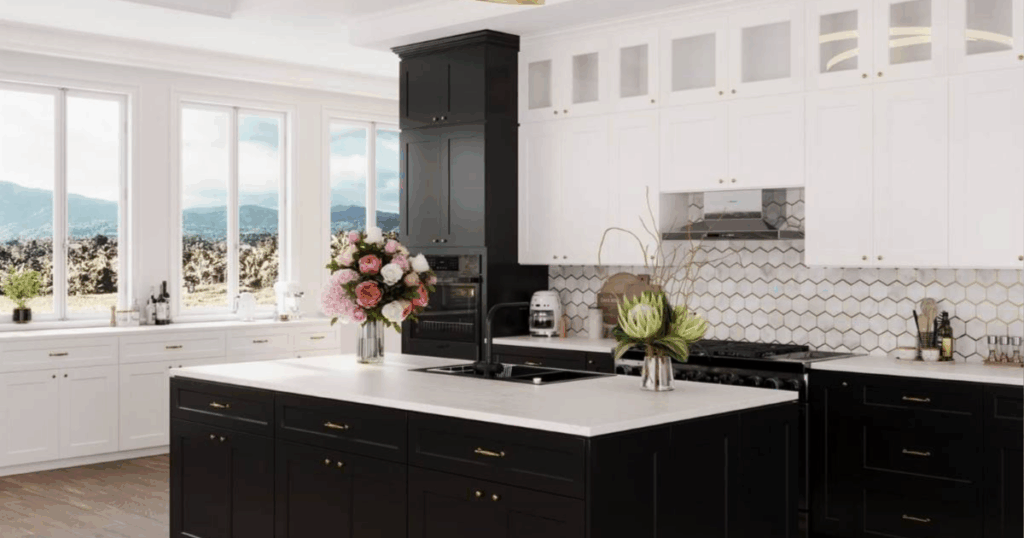
How to Maintain Your Organized Kitchen
Adopt a One-In, One-Out Rule
In a small kitchen, cabinet space fills up faster than you think. A simple way to stop that is one-in, one-out. If you bring home a new dish rack, let go of something old. Same with pantry items, mugs, or cleaning supplies. It keeps the counter space clear and stops those crowded drawers. Thinking about vertical space and wall space as limits helps too. Once you start using the rule, storage space feels easier to manage, and you don’t lose your open space to random clutter.
Schedule Regular Clean-Ups
Clutter sneaks up, even when you’re careful. That’s why you should set a time to go through your cabinet space. It doesn’t take long. Check pantry items, toss expired food, and move things back into empty containers. Wipe the shelf risers or inside cabinet doors where dust collects.
You may notice your counter space gets messier faster, so always look there first. These quick clean-ups, even just ten minutes, help a tiny kitchen feel bigger. You keep the extra pace you worked for instead of slipping back into chaos.
Rotate and Declutter Regularly
Rotations sound boring, but they work. Keep the Dutch oven you cook with all the time close by, and shove the seasonal baking tray onto overhead shelving or unused space. Pantry space also needs this.
Move older pantry items forward so you actually use them, and get rid of duplicates. Grouping helps you see what’s really there. With limited cabinet space, this matters. It opens up vertical space you didn’t think you had and gives you extra counter space for the stuff you actually use.
Conclusion
A tiny kitchen can feel cramped fast. But it doesn’t have to stay that way. Using multi-functional furniture, using cabinet space wisely, finding storage in wall space or vertical space, and even tucking things in the cabinet door make a difference.
Clear containers, drawer dividers, or a lazy Susan turn unused space into something useful. Keep pantry items together, cut down countertop clutter, and you’ll notice extra counter space showing up. Simple habits really do keep the kitchen open and workable.
FAQs
How do I decide where to put things in our kitchen?
Put daily items in easy-to-reach cabinet space. Use vertical space, inside cabinet doors, or empty wall space for rarely used items. Keep pantry items grouped, heavy pots low, and free up counter space. This keeps your tiny kitchen organized and open without wasting storage space.
What are the best storage solutions for small kitchens?
Stackable shelf organizers, drawer dividers, and lazy Susans save cabinet space. Hooks for mugs or utensils use wall space. Clear containers for pantry items and shelf risers maximize vertical space. Multi-functional furniture also creates extra counter space and open space in a tiny kitchen.
How do I make the most of corner shelves?
Use a lazy Susan or pull-out bins in corner cabinets to reach items easily. Add vertical space with shelf risers or tension rods. Store small appliances or pantry items there. It frees cabinet space, saves counter space, and makes every square inch usable.
How do I organize spices with limited cabinet space?
Put spices on racks inside cabinet doors or use clear containers in the pantry space. Drawer dividers or shelf risers help keep them neat. Drawer dividers or shelf risers help keep them neat. Group them together near the prep area to save counter space and make cooking in a tiny kitchen faster and simpler.
What’s the best way to store pantry items with limited space?
Use stackable bins and clear containers to maximize cabinet space. Open shelving or empty wall space works for extra storage space. Group items together, rotate old stock, and use vertical space. This keeps your tiny kitchen organized while freeing up counter space and extra open space.
